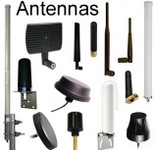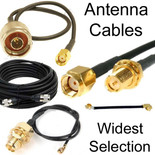Antennas, Antenna Cables, Wireless Products: Technical Articles
BNC cables for MADI Digital Audio Standard: RG59 and RG179
75-Ohm BNC cables for Digital Audio
Our BNC cables made with RG59 and RG179 are compliant with the MADI digital audio standard, which can support multiple channels of digital audio.
MADI-compliant BNC Digital Video Cables: 75-Ohm: RG59 and RG179

BNC cable assemblies are used for Multichannel Audio Digital Interface (MADI). MADI is a digital audio standard capable of supporting multiple digital audio channels. These standards were developed by the Audio Engineering Society (AES), comprising manufacturers and audio industry professionals, including Sony, Phillips, and Mitsubishi.
The cable's quality is critical to an audio system's overall performance.
As MADI carries up to 56 audio channels, a dysfunctional or failed cable will affect all the channels and potentially prevent the audio equipment from functioning. Data Alliance’s 75-Ohm BNC cables meet such standards.
The coax cable used for MADI should match the attenuation of RG59U with a loss of 12 dB at 100 MHz and 18dB at 200 MHz for a 100-meter (368 feet) cable length. For longer cable runs (100 meters), a coaxial cable that exceeds these parameters (i.e., loss or double-shielded cable) should be used. Testing will determine the maximum length that can be used without excessive noise.
MADI digital audio data transfer over copper links is capable of signal transmission over distances greater than 100 meters (328 feet). The AES standards specify 75-Ohm BNC connector cables for use. MADI has a data rate of 100 Mbits per second, which produces a symbol or baud rate of 125 MHz. Data transfer is over channels numbered 0 to 63.
MADI audio installation may be permanent building installations or external patch systems. BNC cable assemblies must be fully compatible and impedance matched with MADI systems, mixers, and consoles, or the audio quality will deteriorate. The standard cable is usually a 75-ohm RG59U cable used for digital video.
The MADI standard was first released in 1991, with the most recent revision published in 2008. It provides specifications and bit-level descriptions for serial digital transmission over either coaxial cable or fiber-optic lines. Transmission along the lines is unidirectional and can have between 28 and 64 channels, each with an audio bit depth of 24 bits.

Multichannel Audio Digital Interface (MADI): a standard for Audio Over Coax
Multichannel Audio Digital Interface, or MADI, is an advanced industry standard for transmitting multichannel digital audio. It supports simultaneous transmission over 64 audio channels via a single coaxial cable with limited loss over hundreds of meters.
MADI has emerged as an audio interface technology capable of superseding the cumbersome audio multicore snakes (composite cables that carry up to 64 individual wires in a stiff outer jacket) used in audio engineering. The simplicity of using a single coaxial cable means that common problems encountered with using multicore cable are bypassed, including:
- Stiffness
- Weight
- Signal losses
- Awkward handling and routing
This makes MADI a convenient solution for pro audio requirements, as coax is cheaper, more flexible, and able to deliver the same overall functionality as a snake cable. MADI also delivers sample-accurate transmissions over long distances without the troubleshooting and maintenance needs of multicore.
Audio industry insight and expertise are at the forefront of this digital audio technology.
These standards were developed by the Audio Engineering Society (AES), comprising manufacturers and audio industry professionals, including Sony, Phillip, and Mitsubishi. The MADI standard was first released in 1991; the most recent revision was published in 2019.
Leading audio manufacturers have led the development of MADI as a standard interface for multichannel digital audio transfer. This agreed specification describes the data organization for this digital audio technology and specifies the simplex transmission format over coaxial cable with a 75 Ohm impedance. This collaborative effort aims to meet the critical mission objectives of:
- Simple installation, engineering, and use.
- Creating a complete functional system
- Being cost-effective and straightforward, the uptake and implementation of this technology are easily justified.
- this technology's implementation is not dependent on specific hardware or software.
MADI's development and refinement as a leading audio interface has taken place in response to industry demand, building on the established two-channel interface outlined in AES3.
There has been a steadily increasing uptake of digital audio equipment and rising demand for more audio channels for large-scale sound production.
MADI provides specifications and bit-level descriptions for serial digital transmission over coaxial cable or fiber-optic lines. Transmission along the lines is >unidirectional and can have between 28 and 64 channels, each with an audio bit depth of 24 bits. MADI digital audio data transfer over pure copper links (versus copper-clad steel) is capable of signal transmission over distances greater than 100 meters (328 feet).
How does a Multichannel Audio Digital Interface work?
The support of multiple channels by a single cable is achieved using Time Division Multiplexing (TDM), keeping AES/EBU signals in series. This digital signal transmission method allows the independent audio signals from each channel to use the single coax by using a system of synchronized switches. The switching creates an alternating pattern of sequential short transmissions from each channel on the line.
Unidirectional TDM provides a point-to-point interface between the source and destination for the 64 channels it supports. The standard sample rate is 44.1 and 48 kHz on a coaxial cable with 75 Ohm impedance. Increasing the sample rate reduces the available channels, with a maximum of 192 kHz attainable if just 16 channels are used.
Data is transferred using frames and subframes. MADI frames consist of 56 subframes, each containing audio channel, status, and user data for a single channel. Each subframe is 32 bits long, of which at least 24 bits are digital audio data. The frames are then transferred serially, with the next frame only transmitted once the previous one has been received.
Digital audio is a practical and cost-effective upgrade for analog audio systems:
Because coaxial cable is used, the costs of installing multichannel connections are significantly reduced compared to generic analog multichannel systems that not only use multicore cable but also include:
- Breakout boxes
- Circuit connectors
- Stage boxes
- Signal splitter
In comparison, a MADI system is more cost-effective with a more straightforwa setup and cabling while still including all necessary audio signal processing components and functionality, including routing, merging, splitting, redundancy, and remote control. This makes the cost of audio installations in sizeable real estate like theaters or stadiums far cheaper and future-forward. MADI installations are also low maintenance in comparison to analog audio, which often requires retrofitting of larger and larger snakes if the number of audio channels is to be increased. The flexibility of MADI audio over coax makes it ideal for various settings, including multiroom production studios, outside broadcasts, live studios, and pop-up installations. MADI hardware, such as interface boxes, routinely carry fiber optic and female BNC coaxial connector ports.

75-Ohm BNC cables for MADI Digital Audio
The MADI audio standard specifies using 75-Ohm coaxial cable terminated by BNC connectors. These higher-impedance BNC connector cables are widely used for audio applications and selected for use by other AES standards.
MADI digital audio data transfer over copper links is capable of signal transmission over distances greater than 100 meters (328 feet). MADI has a data rate of 100 Mbits per second using this coaxial cable. This produces a symbol or baud rate of 125 MHz
The cable's quality is critical to an audio system's overall performance.
As MADI carries up to 56 audio channels, a dysfunctional or failed cable will affect all the channels and potentially prevent the audio equipment from functioning.
The coax cable used for MADI should match the attenuation of RG59U with a loss of 12 dB at 100 MHz and 18dB at 200 MHz for a 100-meter (368 feet) cable length. For longer cable runs (>100 meters), a coaxial cable that exceeds these parameters (i.e., low-loss or double-shielded cable) should be used. Transmission distances achieved over coax are also affected by the performance of the MADI transmitting hardware used to drive the signals down the coax and the sensitivity of the receiving equipment to which the coax is connected. Testing will determine the maximum length that can be used without excessive noise.
The quality of the cable assembly also matters. High-quality BNC connectors that correctly terminate the cable with crimping or soldering provide a low-loss connection with discontinuities kept to a minimum. If the cable is self-assembled, crimping, with the correct tool, often proves more reliable than soldering.







